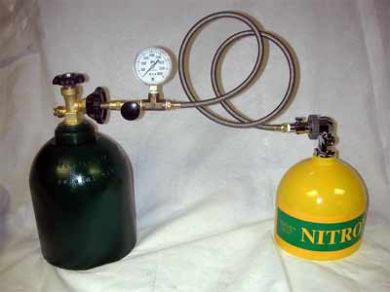I will not jump into the discussion.Thoughtful information, thanks. The reason of course for the shallower deco/safety stops at altitude is due to the less than 1ata at the surface once you surface....interesting twist if I took it as you described above...deeper use of 100% oxygen at deco/safety stop will indeed widen/increase the Oxygen Window and give greater protection against symptomatic or asymptomatic bubbling/tissue damage. Greater [deeper] the gradient with oxygen the greater the reduction of DCS; higher oxygen tensions short of acute oxygen toxicity the higher the benefit. Still TODs and altitude tables key to the reduced atm pressure once you surface, so doing deeper deco stops is a no no and if breathing oxygen it may or may not fit the tables. Sticking to deco/safety stop depths published [your choice which tables] for surface altitudes but breathing 100% oxygen at these stops gives the greatest benefit; as you say a 'win-win'. Assuming you are diving within NDL, there will only be a single "deco" stop at the prescribed "safety stop" depth. One in the same.
As an aside, 1.6ata limit on 100% oxygen is a very conservative pressure limit. But I intend to adhere to it; remember chamber treatments [Tables 4 and 6 for example] often use 100% oxygen from bibs for 20-25mins at 60fsw pressure with 5 min air breaks in between repeated oxygen periods. I am not recommending going anywhere near 4ata used in chamber; but depending on the individuals oxygen tolerance there was a long time past practice of limiting 100% oxygen to 2ata. Read some of the pioneer diver Hans Hass's oxygen rebreather adventures; way beyond my comfort zone but enlightening.
Also important to not mix recompression protocols with decompression protocols. As a solo diver decompression is my only option [every dive ascent is a decompression event] and any recompression treatment will be after the fact in a chamber.
Now any recommendations out there for a vendor selling 100% oxygen dive regulators and tank valves, valves that commercial gas companies will fill with 100% oxygen? Thanks.
Ha! Just saw the best way to protect my 'old bod' is to limit the nitrogen load....I agree and I will do that with the extra protection when using 100% oxygen as described...but you know staying shallow does not have the allure of going deep! I will trade off BT for Z.
DSO
Just one warning, because you said something which is a common misunderstanding.
Comparing PO2 while diving with PO2 in a chamber. It cannot be compared, because the CO2 loading is greater while diving. CO2 increases oxygen toxicity. That's why 1.6 is the maximum while diving and in a chamber it's much larger (I think 2.8?).
1.6 is not conservative. Its a function of time and pressure. 1.6 can absolutely lead to damage of the lungs and cns. I personally know 2 divers, who had huge(!) problems on 1.6.
Please don't underestimate the dangers of oxygen while diving.
For the setup part.. get certified and dive with a small oxygen stage. It's not uncommon for aged recreational divers to do their safety stop on oxygen. If you have problems getting the fills, because the shop is far away. Get a big tank and transfill to the stage. Correct certificate and equipment required of course..




